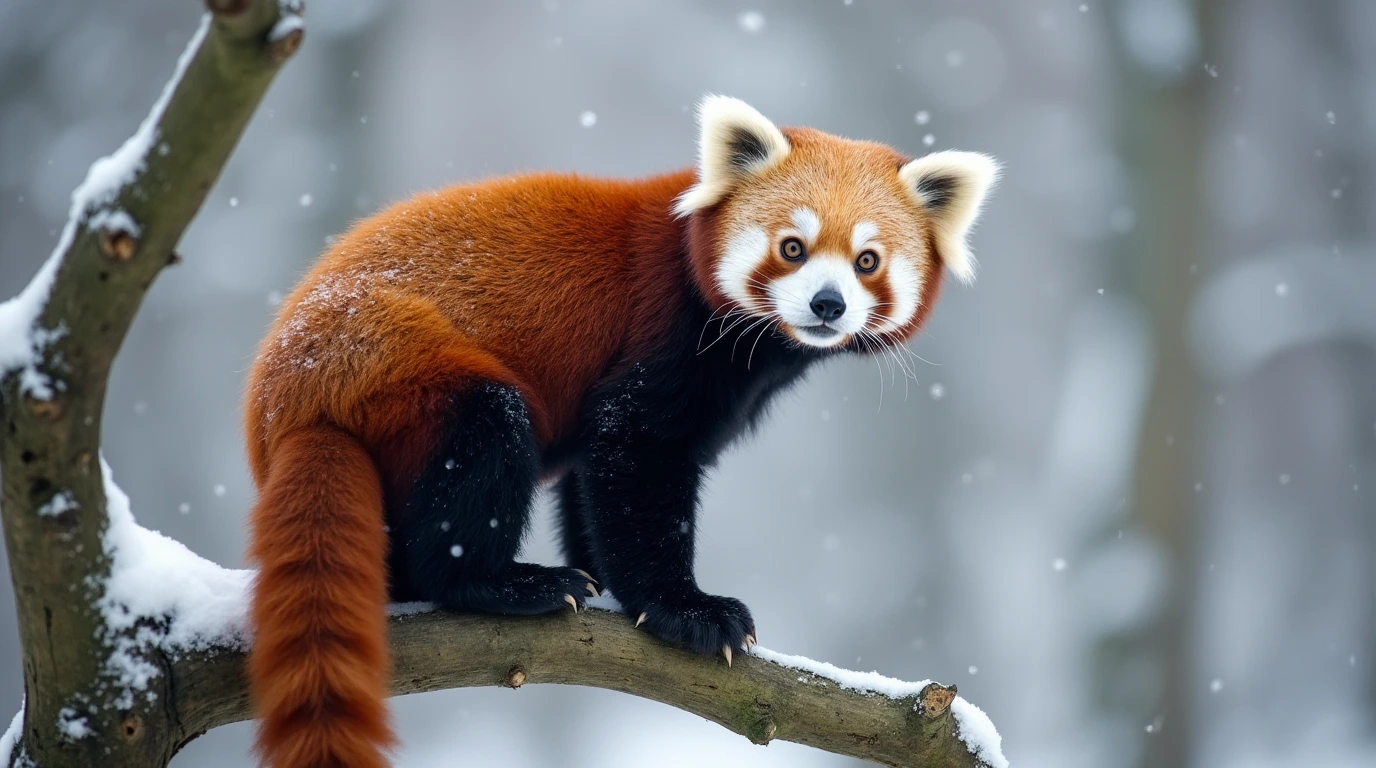Red pandas have evolved a unique set of adaptations that allow them to thrive in the cold, mountainous forests of the Himalayas and southwestern China. Living at elevations ranging from 7,200 to 15,700 feet (2,200 to 4,800 meters), they endure freezing temperatures, rugged terrain, and limited food availability. Their survival depends on a combination of physical traits, behavioral strategies, and dietary specialization, all of which help them navigate the challenges of high-altitude environments
One of the red panda’s most important adaptations is its thick fur coat, which provides insulation against the cold. Their bushy tail serves as both a blanket and a balancing tool, while their fur-covered footpads prevent heat loss on snowy surfaces. Their arboreal lifestyle allows them to avoid predators, and their false thumb helps them grasp bamboo, their primary food source. Additionally, their slow metabolism and crepuscular activity patterns enable them to conserve energy in harsh conditions
In this article, we will explore the physical, behavioral, and environmental adaptations that enable red pandas to survive at high altitudes. We will also examine how climate change is impacting their natural habitat and what conservation efforts are in place to protect this species
Physical Adaptations That Help Red Pandas Survive at High Altitudes

Red pandas are specially adapted to withstand the harsh conditions of their high-altitude habitat, where temperatures often drop below freezing and food sources can be scarce. Their survival depends on a combination of dense fur, specialized limbs, and unique climbing adaptations that allow them to navigate snowy and rugged landscapes efficiently
How Thick Fur Provides Insulation in Cold Mountain Climates
One of the red panda’s most essential adaptations is its double-layered fur coat, which serves as a powerful insulator against extreme cold. The undercoat consists of a dense, woolly layer that traps body heat close to the skin, while the longer, coarser guard hairs form an outer barrier that repels moisture and wind. This dual-layered system ensures that red pandas remain warm even in temperatures as low as -4°F (-20°C)
Unlike many mammals that develop thick fur only in winter, red pandas maintain a consistently dense coat throughout the year, making them well-suited for life in the Himalayas. Their fur extends beyond their body to cover their ears, legs, and even the soles of their feet, preventing heat loss and protecting them from frostbite. The reddish-brown coloration of their coat also provides a form of camouflage, blending seamlessly with moss-covered trees and autumn foliage, helping them avoid predators
The Importance of the Red Panda’s Bushy Tail for Warmth and Balance
A red panda’s bushy tail, which can grow up to 18 inches (46 cm) in length, is another key adaptation that helps it survive in cold, high-altitude environments. This thickly furred tail serves two primary functions: heat conservation and balance
During winter, red pandas often curl into a tight ball and wrap their tails around their bodies like a blanket, covering their faces and extremities to retain warmth. This behavior is especially important at night when temperatures drop significantly. The tail’s dense fur acts as insulation, preventing cold air from reaching the red panda’s skin while minimizing heat loss
Beyond warmth, the tail also provides stability while climbing, allowing red pandas to move effortlessly across narrow, snow-covered branches. As arboreal animals, they rely on their tails for balance, much like a tightrope walker uses a pole. This adaptation helps them navigate treetops safely, even in icy conditions
Unique Physical Traits for Navigating Snowy and Rugged Terrain
In addition to their fur adaptations, red pandas possess specialized limbs and claws that allow them to move efficiently through their mountainous habitat. Their short, strong legs provide stability on uneven terrain, while their semi-retractable claws offer a powerful grip for climbing trees and gripping bamboo stalks. These claws function similarly to those of a cat, allowing red pandas to dig into tree bark and maintain their footing in slippery conditions
Another remarkable adaptation is their fur-covered footpads, which act as natural snowshoes. Unlike many carnivores that have exposed toe pads, red pandas have a thick layer of fur covering the bottoms of their feet. This provides insulation against the cold ground and increases traction on icy surfaces, preventing them from slipping
Their ability to descend trees head-first is another crucial survival trait. Unlike most climbing mammals that back down trees, red pandas rotate their ankles outward and use their sharp claws to grip the bark, allowing them to move downward with ease. This ability is particularly useful when escaping predators or moving quickly between feeding sites
For more insights into the physical adaptations of red pandas, including how their limbs and claws assist in climbing, you can explore research from the Sequoia Park Zoo
Behavioral and Dietary Adaptations of Red Pandas in High-Altitude Habitats

Surviving in the cold, mountainous forests of the Himalayas requires more than just physical adaptations. Red pandas have developed behavioral strategies and specialized feeding habits that allow them to thrive in an environment where food is scarce, predators are present, and temperatures can fluctuate dramatically
How Red Pandas Adapt Their Diet to Limited Food Sources
Red pandas are bamboo specialists, meaning that the majority of their diet consists of bamboo leaves and shoots. Unlike giant pandas, which can consume thicker stalks, red pandas focus on the more digestible leaves and tender shoots. Since bamboo is nutritionally poor, red pandas must eat large quantities to meet their energy needs, consuming up to 20,000 bamboo leaves per day
To supplement their diet, they occasionally eat fruits, berries, acorns, roots, and small insects, providing additional nutrients. This opportunistic feeding behavior is especially important during winter when bamboo leaves may be frozen or covered in snow. Unlike some cold-weather animals that hibernate during food shortages, red pandas remain active and adjust their foraging habits to match seasonal changes in bamboo availability
Their sharp molars and strong jaws are specifically adapted for chewing tough plant material. The ridged surfaces of their teeth help them efficiently break down fibrous bamboo, allowing for better digestion. Since their digestive system processes bamboo inefficiently, red pandas compensate by spending a significant portion of their day—up to 13 hours—eating
The Role of the False Thumb in Survival and Feeding
One of the red panda’s most distinctive features is its false thumb, an elongated wrist bone that functions like an opposable digit. This adaptation allows them to grasp bamboo stalks with precision, making it easier to strip leaves and manipulate food. The false thumb provides a significant advantage in their arboreal environment, where dexterity is essential for feeding efficiently while perched on narrow branches
Beyond feeding, the false thumb also plays a key role in climbing, allowing red pandas to grip tree trunks securely as they navigate their habitat. This adaptation gives them an edge in their high-altitude ecosystem, where they must climb frequently to access food and evade predators
Strategies Red Pandas Use to Avoid Predators in Mountainous Regions
Red pandas share their habitat with predators such as snow leopards, martens, and large birds of prey. To minimize the risk of predation, they rely on a combination of stealth, agility, and camouflage to remain undetected. Their reddish-brown fur blends seamlessly with the moss-covered trees and autumn foliage of their environment, making them difficult for predators to spot from a distance
Their arboreal lifestyle provides an additional layer of protection. Unlike many mammals that rely on speed to escape predators, red pandas prefer to retreat to the safety of the treetops. When threatened, they climb to higher branches where larger predators cannot follow. In extreme cases, they display defensive behaviors such as standing on their hind legs and using their sharp claws to swipe at threats, a tactic meant to intimidate attackers
Another important behavioral adaptation is their crepuscular activity pattern—they are most active during dawn and dusk. This schedule reduces their chances of encountering predators, many of which are either diurnal (active during the day) or nocturnal (active at night). By foraging and moving during twilight hours, red pandas can navigate their environment while minimizing risk
For further insights into how red pandas adapt their diet and behaviors to survive at high altitudes, you can explore research from the Smithsonian’s National Zoo
Environmental Challenges and the Future of Red Panda Adaptation

While red pandas have evolved to survive in the harsh conditions of high-altitude forests, climate change, habitat loss, and human activity are posing significant threats to their long-term survival. These environmental changes are disrupting their food sources, altering their habitat, and making it more difficult for red pandas to thrive in the wild
How Red Pandas Regulate Metabolism to Conserve Energy in Cold Weather
One of the key survival strategies of red pandas is their ability to regulate their metabolism based on environmental conditions. Unlike some mammals that rely on fat reserves to endure harsh winters, red pandas have developed an energy-efficient metabolism that allows them to survive on a low-calorie diet of bamboo
During colder months, red pandas can slow down their metabolic rate, reducing their energy consumption while still remaining active. This behavior is similar to torpor, a state in which an animal temporarily reduces its body temperature and activity levels to conserve energy. By limiting their movements and foraging more selectively, red pandas can maintain their body heat while minimizing the need for excessive food intake
This metabolic adaptation is particularly important in winter when bamboo leaves may be covered in snow or frozen, making them harder to digest. Red pandas compensate by eating less and resting more, ensuring they do not waste unnecessary energy searching for food that may be scarce
The Impact of Climate Change on Red Panda Habitats and Food Supply
Climate change is one of the biggest threats to red pandas, affecting both their habitat and their primary food source. Rising global temperatures are altering the ecosystems in which red pandas live, leading to shifts in bamboo growth patterns. Since bamboo is highly sensitive to temperature and rainfall changes, warming trends are causing some bamboo forests to decline, reducing the amount of available food
Additionally, higher temperatures are forcing red pandas to move to higher elevations in search of cooler environments. However, as they climb higher, they encounter limited forest cover and fewer resources, increasing competition for food and shelter. In some regions, bamboo die-offs have been observed due to extreme weather conditions, further exacerbating the food scarcity problem
Changes in snowfall patterns also pose a challenge. While red pandas are well-adapted to snowy conditions, inconsistent snowfall and unseasonal weather fluctuations can disrupt their normal foraging behaviors. Warmer winters may prevent bamboo from developing properly, while sudden snowstorms can bury food sources, making them harder to access
Conservation Efforts to Protect Red Pandas from Habitat Loss
To address these challenges, conservation organizations are implementing strategies to protect red panda habitats, restore forests, and create wildlife corridors that allow red pandas to migrate safely between different regions. Reforestation projects aim to preserve the dense bamboo forests that red pandas depend on, ensuring that food sources remain stable despite climate change
Wildlife corridors are particularly important because they connect fragmented forest areas, enabling red pandas to move between habitats without crossing human-dominated landscapes. This helps reduce human-wildlife conflict and minimizes the risk of poaching or accidental harm
In addition to habitat protection, community-based conservation programs are playing a crucial role in red panda survival. Many initiatives focus on educating local communities about the importance of red pandas, promoting sustainable forestry practices, and reducing illegal hunting. Some conservation programs also employ local villagers as forest guardians, ensuring that protected areas remain safe from deforestation and poaching
Zoos and breeding programs also contribute to red panda conservation by maintaining captive populations that help raise awareness and support genetic diversity. Captive breeding efforts ensure that healthy populations exist in case reintroduction into the wild becomes necessary
While red pandas face significant environmental challenges, ongoing conservation efforts provide hope for their future. By addressing climate change, protecting habitats, and promoting sustainable coexistence with human communities, conservationists are working to ensure that red pandas continue to thrive in the high-altitude forests they call home
For more details on red panda conservation and efforts to combat habitat loss, you can explore research from the International Fund for Animal Welfare (IFAW)













